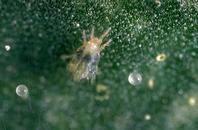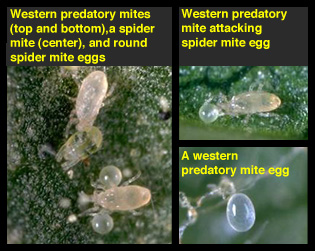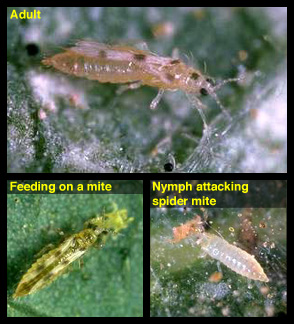![]()
 Every year in Lodi there are a few vineyards that have a late-season infestation of spider mites, especially the Pacific spider mite. By late-season I mean late August or September. Typically the grower’s attention during that time period is shifting to harvest and there is the question of whether or not the mite infestation needs to be treated.
Every year in Lodi there are a few vineyards that have a late-season infestation of spider mites, especially the Pacific spider mite. By late-season I mean late August or September. Typically the grower’s attention during that time period is shifting to harvest and there is the question of whether or not the mite infestation needs to be treated.
One might think that the mite population will continue to increase throughout the fall months if action isn’t taken, but that is generally not the case. At some point in time the mites will go into a resting state known as “diapause” and the population will not increase.
There is some disagreement and uncertainty regarding what is the cue that triggers diapause in the Pacific spider mite. Some people believe that it is triggered by day length while others favor temperature as the key factor. I personally believe that diapause is triggered by the nutritional status of the leaves that the mites are feeding on, but in practical terms it really doesn’t matter.
__________________________________________________________________________________
According to UC IPM Online…
Western predatory mite (Galendromus occidentalis)
Description: Like other mites, western predatory mites do not have antennae, segmented bodies, or wings. They pass through an egg stage, a six-legged larval stage and 2 eight-legged immature nymphal stages before becoming adults.
Western predatory mites are about the size of twospotted spider mites, but lack spots, range in color from cream to amber red (depending on what they just recently consumed), and are shinier and more pear-shaped than their prey. The shiny, oval eggs of the western predatory mite are larger than spider mite eggs. In addition, predatory mites are more active than pest mites, only stopping to feed. Under magnification the mouthparts of predatory mites can be seen extending in front of their body while pest mite mouthparts extend downward to feed on plants.
The preferred foods of western predatory mites are mites of all stages, including eggs, but they also feed on pollen and other food. The western predatory mite is commercially available and is commonly released against Tetranychus spp. spider mites such as the Pacific spider mite and the twospotted spider mite. Effective control of spider mite pests has been documented in various many crops and ornamentals. The western predatory mite tolerates hot climates as long as the relative humidity is above about 50 percent.
__________________________________________________________________________________
Mites will tell you when they are going into diapause and the population will no longer increase by stooping egg laying. It is therefore important, in addition to looking at damage to the leaves and the number of mites on the leaves, to look at the number of eggs on the leaves. When you can no longer find eggs then the population is not going to increase.
In order to look for mite eggs on grape leaves you are going to need a high-quality hand lens. I buy mine from Forestry Suppliers. Specifically, I use the Bausch & Lomb® Hastings Triplet Pocket Magnifier with a 14x magnification.
There are a couple of other details to keep in mind when looking for mite eggs in a colony of spider mites on a grape leaf. Spider mite eggs are spherical while predatory mite eggs are oval. You probably won’t see a lot of predatory mite eggs, but keep in mind that oval eggs are a good sign and not an indication of a problem. In addition, keep an eye out for predators such as six-spotted thrips because even if you have mite eggs they have a voracious appetite for those eggs.
If I am right and diapause is triggered by the nutritional status of the leaves then pay special attention to vineyards that have lots of fresh young leaves in the fall such as non-bearing young vineyards. These vineyards may continue to have mites laying eggs even after egg laying has stopped in mature vineyards.
Also, if you do decide to treat a late-season mite infestation in a bearing vineyard take into consideration the pre-harvest interval of the miticide that you are going to use. One popular, inexpensive miticide has a 28-day pre-harvest interval and you may not have that much time before harvest.
__________________________________________________________________________________
According to UC IPM Online…
Sixspotted thrips (Scolothrips sexmaculatus)
Description: Thrips are tiny, 2-3 mm (less than 1/8 inch) in length, slender insects with long fringes on the margins of their wings. Thrips undergo incomplete metamorphosis, have multiple generations per year, and can be phytophagous or predaceous. Sixspotted thrips adults can be distinguished from other species by the three dark spots on each wing cover of the mostly pale-yellow adult. Nymphs are translucent white to yellow and difficult to discern from other thrips species. Adults and larvae are entirely predaceous, feeding most commonly on mites such as the European red mite, cyclamen mite, and Tetranychus spp. spider mites. Sixspotted thrips can rapidly reduce high mite populations, but often don’t become numerous until after mites have become abundant and damaging.
Life cycle: Most mites, such as this Phytoseiulus persimilis, hatch from eggs and develop through three immature stages before becoming an adult. The adult female lays a light-orangish egg near prey that darkens before hatching. A six-legged mite larva emerges and in many predaceous species is relatively inactive, apparently not feeding before molting to the nymph stage. The eight-legged protonymph, deutonymph, and adult are active searchers and begin feeding almost immediately after molting.
__________________________________________________________________________________



